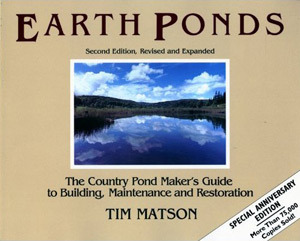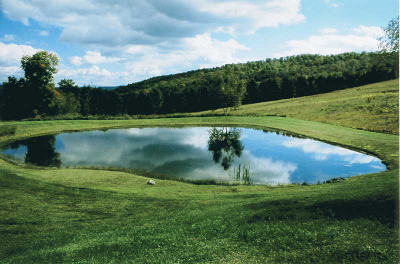
Earth Ponds
 As you can probably tell from all of my pond
experimentation last week, Tim Matson's Earth
Ponds did a
great job getting me excited about playing in the mud. I
read the second edition because a perusal of the table of contents
suggested it was pretty much identical to the newer edition, and
at the time Amazon had a used copy available for only $4.
(If you've looked at the third edition and see updates, I hope
you'll add your two cents' worth as comments on this week's
lunchtime series!)
As you can probably tell from all of my pond
experimentation last week, Tim Matson's Earth
Ponds did a
great job getting me excited about playing in the mud. I
read the second edition because a perusal of the table of contents
suggested it was pretty much identical to the newer edition, and
at the time Amazon had a used copy available for only $4.
(If you've looked at the third edition and see updates, I hope
you'll add your two cents' worth as comments on this week's
lunchtime series!)
The first third of
Matson's book is a chatty story of how he built his own pond
around 1980 in Vermont. He cleared trees in a wetland, then
hired a bulldozer to do the excavation. For $850, the
bulldozer operator dug out a large area (about 93 feet by 75 feet)
to a depth of 8  feet. Water seeped
in through the earth as the pond was was being excavated, then
overflow created its own spillway once rains arrived, with Matson
coming along behind to rock the water's path and prevent erosion.
feet. Water seeped
in through the earth as the pond was was being excavated, then
overflow created its own spillway once rains arrived, with Matson
coming along behind to rock the water's path and prevent erosion.
The rest of this
week's lunchtime series will hit the highlights of pond
construction according to Matson, but I wanted to provide a few
caveats up front. Earth Ponds is focused on creating
an earth-bottomed swimming hole that will keep fish happy and
provide a bit of water for the garden, so it won't be relevant to
everyone. If you want to make a little backyard pond like
ours, you'll have to guess and experiment, and if you want to
create a more vibrant ecosystem, you'll have to overlook all of
Matson's attempts to eradicate "weeds" (meaning any aquatic
vegetation) from his pond. Still, I've yet to find a better
book about earth-bottomed ponds, so Matson's text is at the top of
my list.
| This
post is part of our Earth
Ponds lunchtime series.
Read all of the entries: |
Want more in-depth information? Browse through our books.
Or explore more posts by date or by subject.
About us: Anna Hess and Mark Hamilton spent over a decade living self-sufficiently in the mountains of Virginia before moving north to start over from scratch in the foothills of Ohio. They've experimented with permaculture, no-till gardening, trailersteading, home-based microbusinesses and much more, writing about their adventures in both blogs and books.
Want to be notified when new comments are posted on this page? Click on the RSS button after you add a comment to subscribe to the comment feed, or simply check the box beside "email replies to me" while writing your comment.

- Remove comment
